The collaboration between Ireland's Great Hunger Museum of Fairfield and the Irish American Heritage Museum in Albany, New York, and Quinnipiac University continues to highlight the relevancy of The Great Hunger, also known as The Irish Famine.
17 pieces from The Great Hunger Collection are presently on display in Albany.
Quinnipiac University chose Ireland's Great Hunger Museum of Fairfield as the future custodian of the collection— and to ensure that the artwork remains in public view, Ireland's Great Hunger Museum of Fairfield worked with Elizabeth Stack, Ph.D., Executive Director of the Irish American Heritage Museum, and Quinnipiac University to create the first of many temporary exhibitions.
Among the 17 artworks in Albany are three bronze maquettes by renowned bronze sculptor Rowan Gillespie.
Two of the sculptures, Statistic 1 and Statistic 2, are based on Gillespie's time in Staten Island and pay tribute to the thousands of Irish who died after arriving at the Marine Hospital and Quarantine Station during the years of the Great Hunger, 1845-1852. Presently, Friends of Abandoned Cemeteries of Staten Island, headed by Lynn Rogers, oversees the care of the mass burial site.
The third sculpture on display in Albany by Gillespie is The Victim.
In June of this year, IGHMF President John Foley and I met with the sculptor at one of the first Famine sculptures in the world, Famine, on the Quays in Dublin. Gillespie explained the connection between this group of standing figures he sculptured in 1997 and The Victim.
It's June 26, 2023. Visitors to Dublin stroll alongside the River Liffey towards the EPIC Museum or join a tour on the Jeanie Johnston, a famine ship replica. Many stop and take pictures of Famine, seven bronze skeletal statues traveling a perpetual pathway of forced emigration—reminders of starvation, coerced migration, and a perilous shift in the balance of nature.
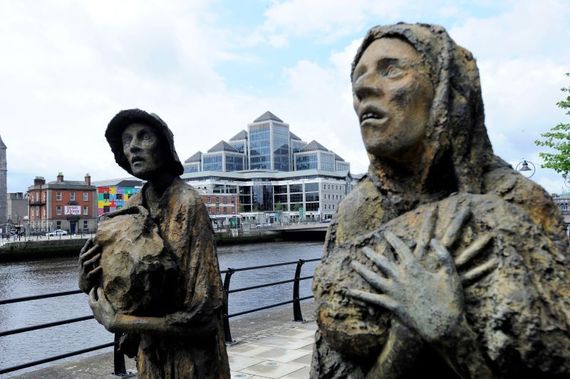
Famine memorial in Dublin. (RollingNews.ie)
A tourist with an iPhone camera at the ready asks a tall, bearded man in a cream sweater standing beside one of the bronze statues on the quays in Dublin to move. It is equivalent to telling DaVinci he is blocking your view of the Mona Lisa. However, Rowan Gillespie obliges. Standing back, Gillespie watches people take photos of the faces he sculpted 27 years ago.
"Most of these are based on a story or someone I knew," Gillespie says.
In 1997, Gillespie discovered he knew very little about the Famine but became steeped in history through his work on these sculptures, commissioned by Norma Smurfit. This interest in the darkest part of Irish history "has stayed with me ever since," Gillespie says.
The seven sculptures on the quays in Dublin are larger than life. Gillespie, who does all of the casting himself, says, "It took a lot out of me."
The faces of two statues are of Gillespie's great-great-grandfather, who emigrated to Canada, and his sister, who died from anorexia.
"She became a very important model," he says, adding, "I learned from her the awful vacant look of someone who is starving."
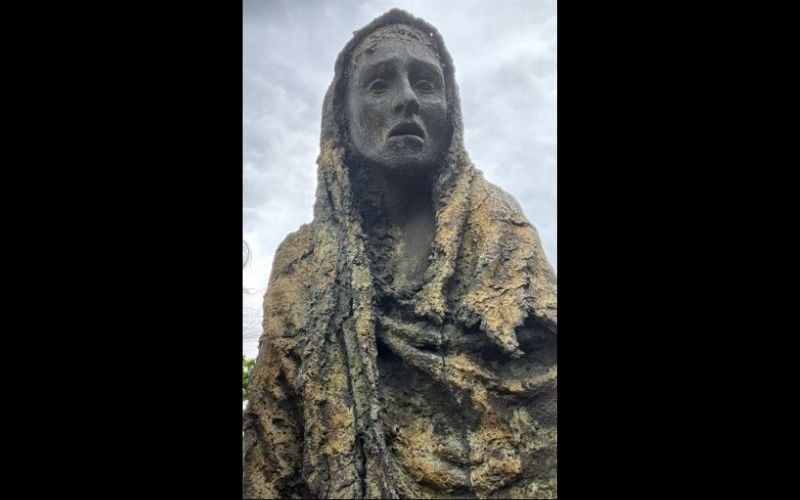
Statue on the quays in Dublin, part of Rowan Gillespie's Famine sculpture. The woman's emaciated features are based on Rowan Gillespie's sister who died from anorexia.Statue on the Quays in Dublin, part of Rowan Gillespie's Famine sculpture. The woman's emaciated features are based on Rowan Gillespie's sister who died from anorexia.
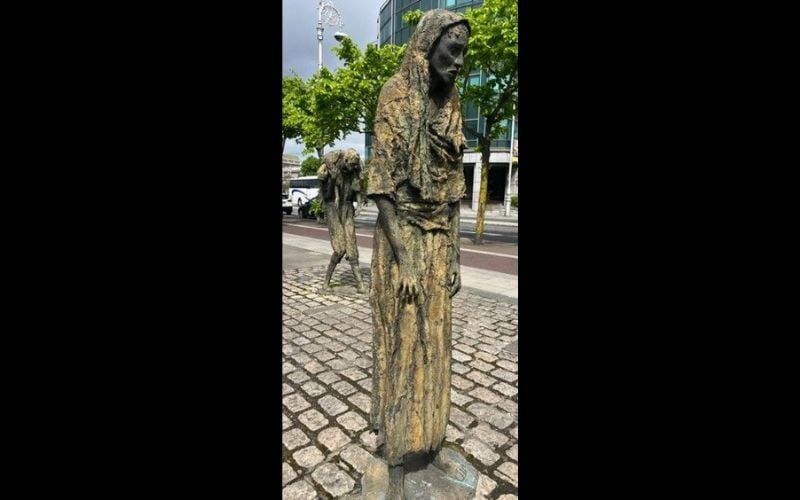
The statue based on Rowan Gillespie's sister who died of anorexia, is one of seven in the Famine sculpture on the quays in Dublin.
The six human figures in Famine each carry something. Five carry bundles, their sole possessions, on their perpetual journey.
The sixth, a man at the rear, has a child across his back. The child's body lies unnaturally, face up, as if the neck and shoulders are dislocated.
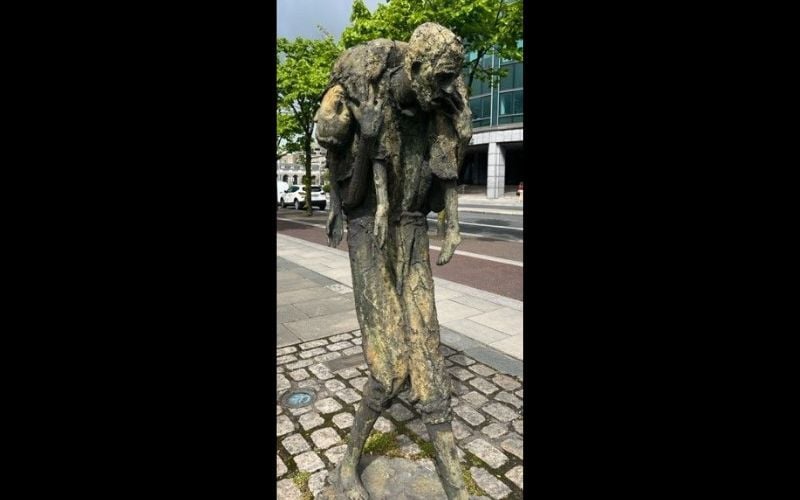
Man carrying a dead child in Rowan Gillespie's Famine sculpture on the quays in Dublin.
A few feet behind them, a dog prowls, waiting for the man to drop the child. "The dog is eyeing up the dead child," Gillespie says.
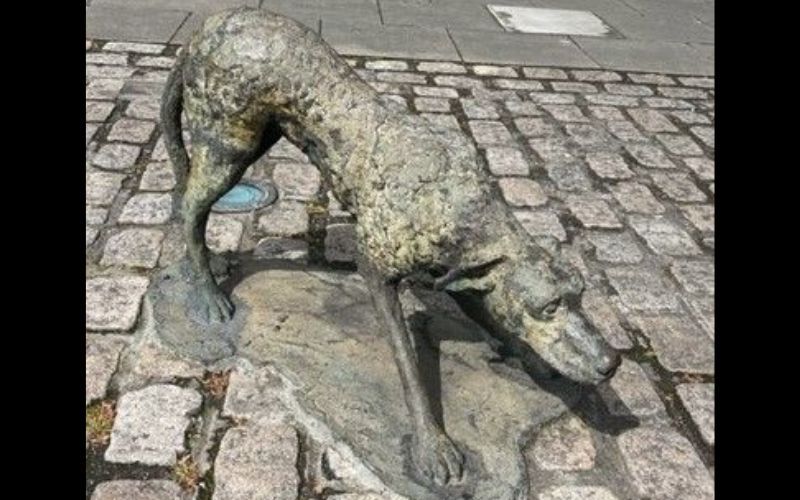
A dog stalks the group of people, ready for the man to drop the dead child. Rowan Gillespie's Famine sculpture at the quays in Dublin.
Initially, the dog was supposed to be a seated child, The Victim— the maquette is part of The Great Hunger Collection. Gillespie realized with the positioning of the sculptures that a sitting figure wouldn't work. "I became fascinated by the dog idea," he says, adding, "The population of dogs thrived during the famine because they were eating the human remains."
In the almost 30 years since he created Famine, Gillespie feels drawn back to The Great Hunger every decade. Gillespie's sculptures in Toronto, The Arrival, in 2008 in Ireland Park show the famine emigrants at their destination.
In 2003, Gillespie was on Staten Island when the remains of famine emigrants long since forgotten were discovered. "Staten Island is a burial ground of Irish emigrants," Gillespie says. The numbers of people who died in Ireland, Canada, and Australia during The Great Hunger have been well documented. Gillespie adds, "What people don't realize is, when they arrived in Staten Island, they died like flies." This event inspired his sculptures Statistic 1 and Statistic 2, also in The Great Hunger Collection.
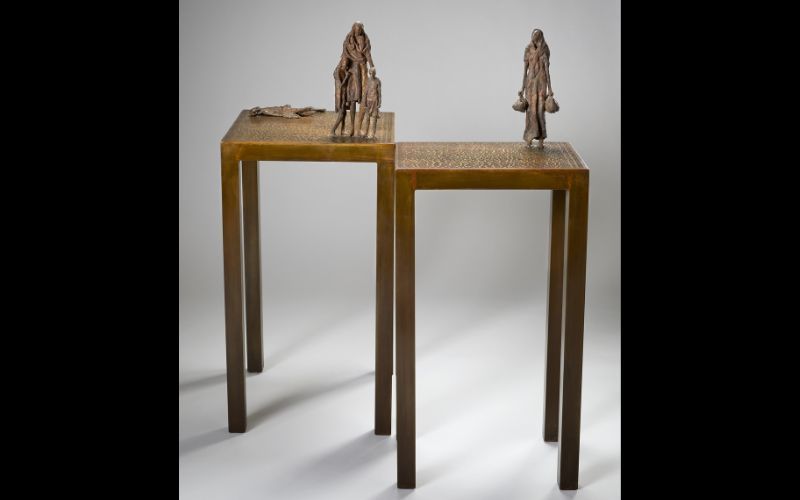
Rowan Gillespie's Statistic 1 & Statistic 2.
"From Staten Island, over ten years later," Gillespie says, "came convicts in Australia."
In 2017, Footsteps, a tribute in bronze to convict women and their children sent to Tasmania, was installed at the exact place where they stepped onshore.
"Convicts for no big crime," Gillespie says, "maybe for stealing a loaf of bread."
Employing 3D imaging, Gillespie used the faces of descendants of female convicts to create the faces of these statues.
Of course, it's all in the past, but why does it matter? According to writer and philosopher George Santayana, "Those who cannot remember the past are condemned to repeat it."
Food shortages, artificial or natural, starvation, and forced migration, Rowan Gillespie's Famine sculptures on the quays in Dublin draw attention from other displaced people today. Ukrainians, who visit and leave flowers, have adopted Gillespie's Famine as a symbol of their present-day troubles.
Historically, too, the Ukrainians experienced an artificial famine. Due to Soviet industrialization and collective farming practices, an estimated 3.5 to 10 million Ukrainians died between 1932 and 1933, commonly called Holodomor. The word Holodomor is Ukrainian; it means "death by starvation."
Gillespie's Famine sculptures stand as reminders that no one should go hungry, coerced emigration due to Famine or war devastates those forced out of their homelands, and keeping the balance of nature is key to human survival.
"It all comes from this sculpture," Gillespie says, watching tourists take close-ups of the faces of starvation he sculpted 27 years ago. Faces that are, sadly, still relevant today.
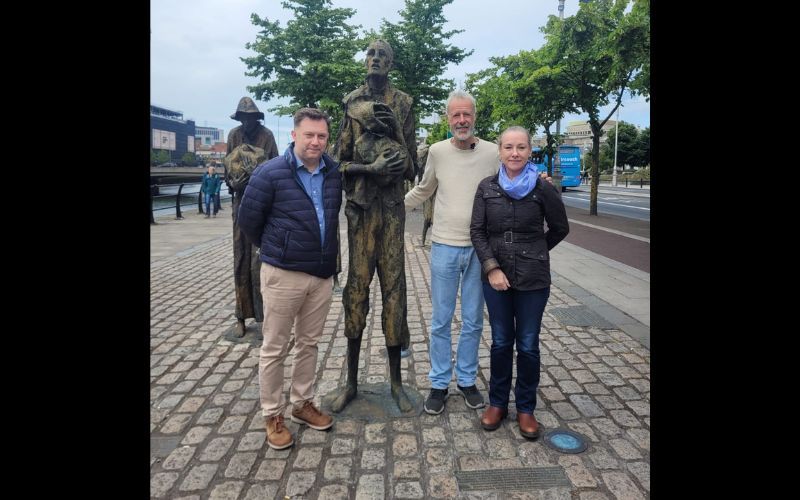
Ireland's Great Hunger Museum of Fairfield President, John Foley, Bronze Sculptor Rowan Gillespie and myself,Loretto Leary standing at Gillespie's Famine sculpture on the Quays in Dublin in June 2023.
The Irish Great Hunger Museum of Fairfield, The Irish American Heritage Center of Albany, and the Quinnipiac University exhibition continues through January. Admission is $10.00 for adults and $8.00 for members. A closing event will take place on Sunday, January 21, 2024, from 2 pm to 4 pm - more details on this event to follow.
Elizabeth Stack's interview with Rowan Gillespie for the Irish American Heritage Museum's series, The Great Hunger, commemorating 175 years since Black '47, is available here.
Rowan Gillespie's website is available here: About Rowan Gillespie.
Rowan Gillespie's first Irish Famine memorial, commissioned by Norma Smurfit over 27 years ago, Famine, on the Quays in Dublin. Video by John Foley, President of Ireland's Great Hunger Museum of Fairfield.
This article was submitted to the IrishCentral contributors network by a member of the global Irish community. To become an IrishCentral contributor click here.
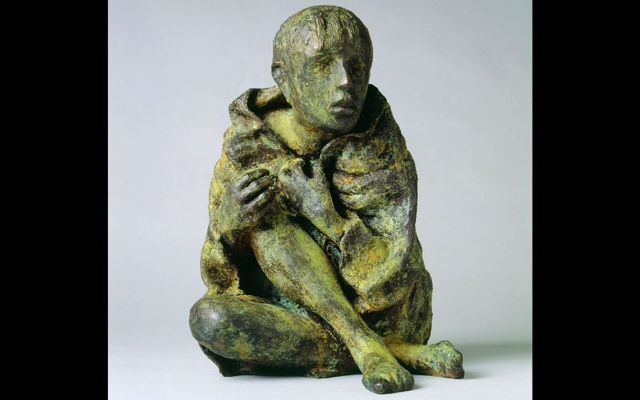



Comments